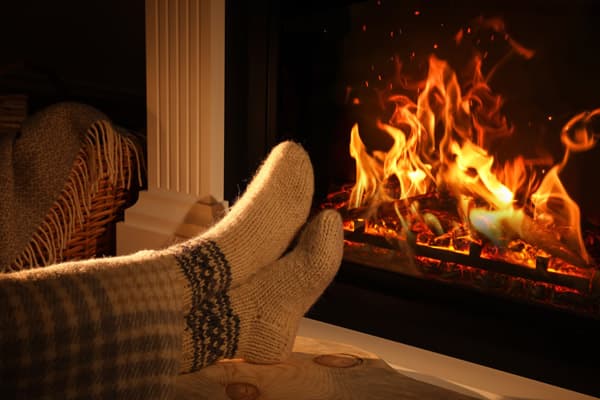
Wood-Burning Fireplaces
Everyone knows about wood-burning fireplaces. It’s the traditional style that comes to mind when someone mentions the word “fireplace.” Crackling wood, flickering flames, and that undeniable scent of toasting wood, nothing beats a wood-burning fire. This type of fireplace requires a conventional chimney to vent the fumes it produces.
The downside, depending on who you ask, is the cleanup. Soot, ash, and burnt wood and coals will be left behind for you to take care of after a fire. It’s not for everyone, but traditionalists swear by this fireplace type.
Gas Fireplaces
There are actually a few types of gas fireplaces, so before you make a purchase, you should know the differences between them. The two types of gas fireplaces are vented and vent-free. These types of fireplaces are both vastly different in how they function. By learning about each of them, you can narrow down which gas fireplace is right for you.

Vented
Vented gas fireplaces work a lot like traditional wood-burning ones. There’s a firebox that’s vented through the chimney, which is how vented fireplace expels combustion byproducts. The difference is that instead of burning wood, vented gas fireplaces use faux logs, most of which are made from ceramic.
People who love the idea of a wood-burning fireplace but not the cleanup that comes with it will also enjoy a vented gas fireplace. These fireplaces have the same look and similar function to a wood-burning fireplace, but without the mess of ash, soot, and burnt wood. While vented gas fireplace do need to be cleaned of carbon build up, it is less frequent than a wood-burning fireplace.
Vent-Free
Don’t have a chimney but want a fireplace? Vent-less fireplaces are for you! Vent-free fireplaces can combust interior air, they keep all the heat they produce inside the living space. Vented fireplaces function similarly, but still require outside air to combust, so there’s not as much heat that’s retained as a vent-less fireplace.
Depending on your situation, a vent-free fireplace is the way to go if you want a fireplace but lack the chimney and masonry to have a traditional one. Although this type of fireplace used to raise safety concerns because the style lacked the ability to vent to the outside, manufacturers are held to high standards during production. Vent-less fireplaces must meet rigorous safety criteria before they’re even switched on.
Electric Fireplaces
Like the vent-free fireplace models, electric fireplaces are another solution for homeowners and condo or apartment dwellers who don’t have a chimney for a traditional fireplace. Thanks to modern technology, you can switch on an electric fireplace with a press of a button.
Many people use electric fireplaces in places where proper venting just isn’t possible. This style is popular for apartments and condos or residences where it’s simply impossible to put a chimney in for a fireplace. The best part of an electric fireplace is that like a vent-less fireplace, it can go anywhere. Electric fireplaces come in a variety of different styles and prices, so you’re sure to find something that works for you.
The only downside of an electric fireplace is that they aren’t the most practical option in terms of actual heat production. They’re really more for aesthetics, and electric fireplaces can become rather expensive, both as an initial purchase and to operate in terms of energy costs. While you still get the look of a fire, you don’t get the smell of a traditional wood-burning fireplace or the same amount of heat as a gas burning one.

Ethanol Fireplaces
You might not have heard of an ethanol fireplace. This style is fairly new, but it’s seen increased popularity on the fireplace market as a flashy, modern option. Like electric and vent-free fireplaces, ethanol fireplaces also don’t require venting so they can go just about anywhere in your house. What makes them different is that because these fireplaces burn ethanol, you have a bright blue flame.
The disadvantages of this modern style are that they need to be frequently top-offed. And although these fireplaces undergo strict safety inspections before they leave the manufacturers, ethanol is still highly flammable. It’s similar to a ventless fireplace. Yes, they’re safe, but you should still exercise precaution. These fireplaces are cool looking and offer a neat alternative, but you still won’t get as much heat as a gas-powered fireplace.
Which One?
Everyone wants a specific feature of a fireplace, so it shouldn’t be too hard for you to narrow down what style is best for you. Do you like the sounds of a traditional fire and don’t mind the cleanup? Then a wood-burning fireplace is for you. Don’t have a chimney but still want a fire? Look into an electric, vent-less, or ethanol fireplace. Do you want the heat and feel of a fire but would rather skip burning wood? Check out vented gas fireplaces. There’s an answer for everyone!
Vertical is raising the bar when it comes to what a chimney and fireplace solutions company can be. Vertical has been in the chimney care business for over 35 years, and we have devoted our time and energy to bring safety to your home. We have spent all 35 years making sure we give our customers the best possible service. Starting your project is easy, contact us today!
